Question
1. A defined benefit pension plan is a plan that specifies either the amount of benefits to be paid upon employees' retirement or a formula
1. A defined benefit pension plan is a plan that specifies either the amount of benefits to be paid upon employees' retirement or a formula used for determining these benefits.
True or False
2. Which of the following is not relevant for the calculation of the net interest cost?
Multiple Choice
a. Projected benefit obligation.
b. Pension plan assets.
c. The discount rate.
d. Current year's contribution to pension plan.
3. Which of the following would not increase the defined benefit obligation?
a. Interest cost accrued on the pension obligation since the beginning of the period.
b. Past service cost.
c. Actual investment income earned.
d. Current service cost.
4. In order to be registered, a pension plan must be trusteed.
True or False
5. Actuarial cost methods use many estimates to determine the annual contributions to be made to a defined benefit plan, one of which includes the company's borrowing rates.
True or False
6. All three funding approaches result in full funding of a pension plan over time.
True or False
7. A trustee is independent and receives the pension contribution from the employer and invests it in accordance with provincial regulations.
True or False
8. For a defined benefit plan:
a. The contributions are fixed and the benefits are variable.
b. The contributions are variable and the benefits are variable.
c. The contributions are variable and the benefits are fixed.
d. The contributions are fixed and the benefits are fixed.
9. Pension plans are said to be "vested" when
a. The employee has the right to receive his pension entitlements if he has at least three years of service.
b. The employee has the right to receive his pension entitlements even if he leaves before retirement.
c. The employee has the right to receive his pension entitlements once his salary reaches a certain level.
d. The employee has the right to receive his pension entitlements when the employee makes contributions.
10. Pension plans that are registered meet Revenue Canada requirements and hence qualify for tax advantages.
True or False
11. Gains and losses from plan settlements and curtailments should be:
a. amortized over a systematic and rational manner.
b. amortized over the average remaining service period.
c. deferred to the balance sheet.
d. recognized in income immediately.
12. A company using IFRS has the following information: Defined benefit obligation at beginning of year $12, 790; current service cost $570; actual return on pension assets $149; contributions made during the year $1, 030; Discount rate used on obligation 6%; payments made to pensioners during the year $135. What is the closing balance for the defined pension obligation?
a. $13, 992
b. $12, 181
c. $12, 046
d. $13, 864
13. On a pension spreadsheet, a company experiencing an actuarial gain on assets is recorded as:
a. Dr. Plan assets Cr. Accrued pension liability
b. Dr. Plan assets Cr. OCI
c. Dr. Plan assets Cr. Cash
d. Dr. Plan assets Cr. Pension expense
14. Costs related to a new pension plan that are necessary to "catch up" for services rendered prior to the inception of the pension plan are classified as:
a. actuarial losses.
b. retroactive deferred charge.
c. past service costs.
d. service costs.
e. transition costs.
15. In the computation of pension elements, which of the following components is likely to increase OCI?
a. Actual return on plan assets greater than expected return on plan assets.
b. Interest cost.
c. Expected return on plan assets greater than actual return on plan assets.
d. Service cost.
Step by Step Solution
There are 3 Steps involved in it
Step: 1

Get Instant Access to Expert-Tailored Solutions
See step-by-step solutions with expert insights and AI powered tools for academic success
Step: 2

Step: 3

Ace Your Homework with AI
Get the answers you need in no time with our AI-driven, step-by-step assistance
Get Started


